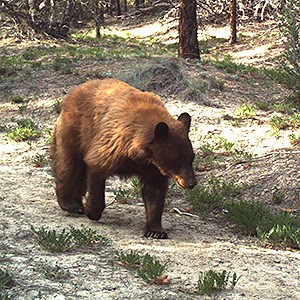
NPS photo (from Bryce Canyon National Park photo library)
As recently as the 1960s, very little was known about bear biology. With the advent of radio tracking and other technology, biologists have been able to answer not only basic questions about bear diets, habitat, and demographics, but also more complicated questions related to changing environments. Effective conservation and management of bears requires that scientists continue to seek information about how bears respond to ecosystem changes, whether natural or human-caused. In addition, social science research is now helping us understand people’s responses to bears and bear management, also known as the human dimensions of bear management. There is increasing recognition that bears are part of coupled natural-human systems, where human values, actions, and management decisions are inextricably linked to the experience of bears on a landscape.
The rise in human population and infrastructure, especially roads, has led to fragmentation of bear habitat. The National Park Service and its partners recognize the importance of connecting parks with other areas of habitat. To do so effectively, however, they must answer questions such as:
- What types of landscape features are barriers to bear movement?
- Are there predictable areas where bears are more likely to be hit by cars (often due to condition of the habitat on either side of the road)?
- Which areas are the most acceptable to people to develop or restore as corridors for bear movement?
These large landscape connections not only enhance the likelihood that individual bears can access adequate habitat but also help maintain the genetic diversity of a population. If animals living in an area are too closely related to each other, they can suffer from inbreeding. DNA analysis can help determine how isolated populations are and how important it is to create ways for these populations to interact. Sometimes, this type of analysis can lead to surprising discoveries. Bears at Glacier Bay National Park and Preserve were isolated during the Little Ice Age (a cooler period roughly between the 14th and 19th centuries), but since the ice has retreated they are now mixing with other bears from Alaska. The NPS biologist who studies these bears wrote a song (7.98 MB WMA | download lyrics 53.4 KB PDF) about the first two brown bears to re-colonize Glacier Bay.
Other questions are related to how bears will respond to rapidly changing environments due to climate change. Polar bears affected by the loss of sea ice are beginning to look for sources of food on land. Over time, how might this new predator affect the prey populations? The seasonal timing of biological events, known as phenology, also is affected by climate change. Bears rely on weather and climate cues to signal hibernation. Could bears eventually stop hibernating due to climate change, and how would their year-round presence on the landscape affect their food resources? How would this change the way that society thinks about bears?
With respect to human-bear interactions, social scientists are helping managers test messages and products that encourage proper food storage, viewing etiquette, and safety precautions. There is also increasing recognition that just like humans, individual bears have different levels of tolerance, curiosity, and aggression. As a bear begins to investigate human spaces, managers need to be able to identify the bear to be successful at changing that bear’s behavior in the future. Once a bear has learned to associate humans with food, it is extremely difficult to affect behavior, and that individual may need to be removed.
Managers also want to know how new park infrastructure affects bears. When construction of new recreation paths was approved in Grand Teton National Park in Wyoming, scientists conducted a study to determine how the new paths and increased human presence might impact black and grizzly bears. They examined the amount of time bears spent in the habitat where the pathways would be located. Once the pathways were built, they noticed changes in the bears’ movement patterns in response to the new paths. They discovered that bears did not shift their home range to avoid humans using the pathways, but instead altered timing of their use, spending more time near the pathways when human use was lower in the mornings and evenings.
Last updated: April 16, 2014
